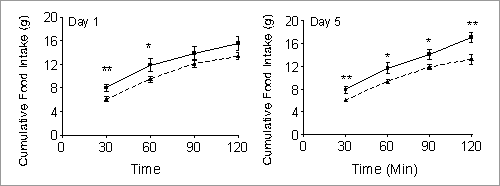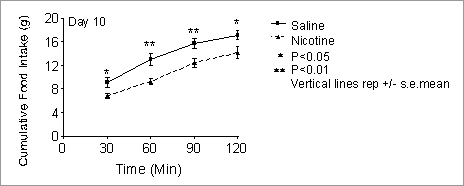Effects of acute and chronic administration of nicotine on food intake in rats
It has been previously shown that acute systemic administration of nicotine (0.8 mg / kg) decreases spontaneous motor activity (SMA) in rats, but with repeated exposure, tolerance develops to the depressant effects and the animals display increased SMA when injected with the same dose of nicotine (Morrison et al., 1972). Nicotine has also been reported to reduce food intake in rats by an action at central acetylcholine nicotinic receptors (e.g. Munster et al., 1975). The present study was undertaken to investigate whether nicotine would produce similar changes on food intake, as described for SMA, after acute and chronic administration. Male Wistar rats (n=16; b. wt. 280 – 330g) were divided into two equal groups and deprived of food for 22 h each day. The animals were injected i.p. with either physiological saline solution (Control Group) or nicotine (0.8 mg kg-1; Test Group) daily for 10 days. On days 1, 5, 10, the rats were put individually into separate experimental boxes immediately after their injections and presented with food and water for 120 min. Food intake was measured, as described previously (Ebenezer, 1990), and analysed by ANOVA and the Newman Kuels post-hoc test. On day 12, both groups of rats were injected i.p. with saline and food intake measured. All measurements were made during the light cycle starting at 14.00 h. Fig. 1 shows the effects of acute and repeated administration of nicotine. On treatment day 1, nicotine produced a significant decrease in cumulative food intake during the first 20 min after administration. The suppressant effect of nicotine on food intake persisted with repeated administration and reduced feeding for a longer period of time after administration. Thus, on treatment days 5 and 10 cumulative food intake was significant decreased throughout the 120 min recording period. There was no significant effect of repeated administration of nicotine on body mass (mean body mass (g) ± s.e. mean on treatment day 10: Control Group 344.5 ± 5.3 g; Test Group 349.3 ± 8.0 g). When both groups of rats saline were injected with saline on day 12, there were no significant alterations in their food intake (for example, mean food intake (g) ± s.e. mean at 120 min: Control Group 18.1 ± 0.7 g; Test Group 17.8 ± 0.8 g). The results of this study confirm and extend those reported previously ( Munster et al, 1975, Li et al., 2000). These data indicate that (i) acute administration of nicotine reduces food intake, and (ii) with repeated administration of nicotine (a) tolerance does not develop to the hypophagia, (b) the suppressant effect on cumulative food intake is prolonged, and (c) there is no effect on body weight. In addition, the results obtained on day 12 (see above) suggest that withdrawal from nicotine does not produce significant changes in ingestive behaviour. Further work, using different dosing regimens and longer periods of exposure to nicotine are needed to extend these findings.
Fig. 1. Effects of acute and repeated administration of nicotine on food intake.
Ebenezer, I.S. (1990) NeuroReport 1, 73 – 76. |



